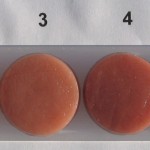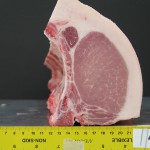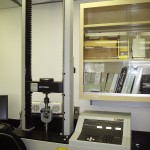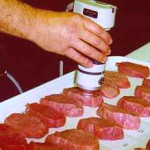In the previous issue of Western Hog Journal (Fall 2007, Vol. 29, No. 2), we summarized the growth performance and carcass traits of nearly 1000 hogs fed diets containing zero-tannin (ZT) fababean (Snowbird) as a full replacement for either field pea or for soybean meal or half ZT fababean, half soybean meal. In this article we report mainly the effects of the same diets on pork yield of the primal cuts and loin quality traits of these hogs. We wanted to ensure that feeding ZT fababean would not compromise pork quality and jeopardize western Canadian pork export markets.
The study was conducted at the Drumloche Research Barn near Irma, AB. The pigs (Fast Pigs, SK) originated from the Lewisville herd within the Alberta Pig Company production system. Upon reaching a market weight of 118 kg, most hogs were shipped for slaughter to Britco in Langley, BC. A subsample of 96 hogs (24 per week) were shipped to Sturgeon Valley Pork at St. Albert, AB for slaughter on four consecutive Mondays. After an overnight chill, the half carcasses (sides) were shipped to Agriculture and Agri-Food Canada (AAFC) Lacombe Research Centre to establish the yield of primal cuts and evaluate pork loin quality.
Fat hardness
Pig carcasses can have very soft fat, very hard fat or something in between. Fat hardness is directly affected by what the pig eats. If the pig’s feed contains saturated fats (like tallow), then the carcass fat will also be more saturated and firmer. On the other hand, if the diet contains high levels of unsaturated fat, such as canola oil, then the carcass fat will also be more unsaturated and softer. Carcasses with fat that is too soft are undesirable because they are more difficult to process and the bacon is more difficult to slice. The hardness of bacon fat is very important to consumers. Bacon slices should separate well at cutting and cooking instead of gelling together. On arrival at AAFC Lacombe (Tuesdays), the half-carcass sides were re-hung in a carcass cooler. The next morning (Wednesdays, approximately 48 hours post-slaughter), the hardness of the second layer of fat beneath the skin, above the second thoracic vertebra, was measured using a durometer. The durometer we used had a scale with values ranging from 0 to 100. The higher the reading, the harder the fat.
Backfat and ribeye dimensions
The amount of lean pork from a carcass and the corresponding payment to producers is estimated from backfat thickness and loin depth measured in the warm carcass. The loin was therefore sawn through between the third and fourth last ribs. This is the site where the grading probe was inserted at the slaughterhouse. A digital picture was taken of the cross-section (Figure 1) and used to measure backfat thickness and loin muscle depth. The picture was also used to measure the ribeye length and width and to calculate the area of this important muscle cut to consumers.
Loin marbling
Marbling refers to the small specks of fat within the muscle (intramuscular fat). The amount of marbling fat in pork chops can influence consumer perceptions of flavour and juiciness. The amount of marbling in the loin for each carcass side was subjectively scored in the cross section pictures taken (Figure 1). Scores were assigned using photographic marbling standards produced by the US National Pork Producers Council (NPPC). A marbling score of 2 or 3 corresponds to approximately 2 or 3% intramuscular fat, respectively.
Pork yield of the primal cuts
As mentioned previously, the amount of lean pork from a carcass can be estimated from backfat thickness and loin depth. To first establish such a relationship, carcasses need to be cut out into primal cuts. The amount of lean, fat and bone is then weighed for each primal cut. Thus, on Wednesdays, the cold carcass sides were weighed prior to splitting them up into the five primal cuts: the picnic, the butt, the loin, the ham and the belly (Figure 2).
Each of the primal cuts, except for the belly, was then carefully separated into fat, bone and lean pork (Figure 2). Each of these tissues was then weighed separately for each primal cut. The yield of the half carcass side for each hog was then calculated as the weight of the dissected lean pork in the picnic, butt, loin and ham plus the weight of the trimmed and squared belly (the bacon piece) and the side ribs. The added weight of lean pork from the primal cuts was then expressed as a proportion of the cold side weight.
The pork loin or back is the most valuable cut from the carcass. The loin eye muscle, referred to as the Longissimus, extends along the length of the back. This muscle is often evaluated as the most representative indicator of pork quality by meat researchers because of its high value to consumers.
Loin colour, structure and firmness
The appearance of fresh pork is what primarily motivates a consumer to select one tray over others in a store display. Two highly experienced observers evaluated the front half of the loin eye muscle for colour, structure and firmness using several scales.
First, they rated the colour of the muscle using a five-point scale according to AAFC standards, ranging from one as extremely pale to five as extremely dark. Second, the observers rated the firmness and structure according to AAFC standards on a five-point scale, ranging from one as extremely soft, sweaty, dough-like, usually  with open and grainy texture, to five as extremely firm, dry, sticky, with closed and grainless texture. Third, theyrated the colour of the pork loins again using plastic resin models developed by the Japanese that can be useful when considering exporting to that country (Figure 3). Scores range from a one being extremely light to a six, which is extremely dark. Values of 3, 4 and 5, are generally desirable for the Japanese export market. Fourth, the color and firmness, respectively, were also subjectively rated using the standards from NPPC. Colour was rated on a six-point scale; the palest loins rated 1 through the darkest loins rating six. Firmness was rated on a five-point scale with one being very soft through to five being very firm.
with open and grainy texture, to five as extremely firm, dry, sticky, with closed and grainless texture. Third, theyrated the colour of the pork loins again using plastic resin models developed by the Japanese that can be useful when considering exporting to that country (Figure 3). Scores range from a one being extremely light to a six, which is extremely dark. Values of 3, 4 and 5, are generally desirable for the Japanese export market. Fourth, the color and firmness, respectively, were also subjectively rated using the standards from NPPC. Colour was rated on a six-point scale; the palest loins rated 1 through the darkest loins rating six. Firmness was rated on a five-point scale with one being very soft through to five being very firm.
To make the colour appraisal more objective compared to the subjective rating of the observers, a special instrument called a colour meter was used to measure light reflectance off the surface of the muscle (Figure 4). The colour meter was placed in full contact with a chop. When activated, the meter flashes a light and measures the characteristics of the light reflected back to it. The meter records four reflectance values: L* is a measure of lightness; higher values indicate more light is reflected back making the surface appear brighter. Increasing positive values of a*, indicate increased levels of red, while higher positive values of b*, indicate increasing yellow. C* (chroma) indicates the degree of saturation, that is, how intense the colour is. Hue angle describes a specific tint, for example, light pink.
Loin moisture and fat content
To consumers, the concentration of moisture in pork is important for juiciness and perceived tenderness. Thus, after evaluating the quality characteristics of the front portion of the loin eye muscle, it was ground for determination of water and fat content. The ground sample was dried in a convection oven at 102ºC for 24 hours. The difference in weight between the wet sample and the dried sample indicated the moisture content.
Consumers have become more aware of the food they eat and are becoming more concerned about reducing fat intake. Fat around a retail cut can be trimmed with a knife, but the fat among muscle fibres (intramuscular) cannot. While consumers desire and select leaner pork in the retail counter, most meat researchers consider a certain amount of marbling fat necessary to ensure a consistent, satisfactory tasting experience unless the product is marinated or otherwise enhanced. So, to evaluate the amount of intramuscular fat, the fat among muscle fibres was extracted by boiling ground loin samples in petroleum ether. The amount of fat was then weighed after evaporating the ether. Loins from pigs with low marbling can have as little as 1% intramuscular fat. A desirable level of marbling that is thought to ensure eating quality without reducing the consumer intent to buy is 2.5 to 3%. Values above 5% fat are indicative of highly marbled pork.
Loin drip loss
When consumers buy fresh pork and take it home, they don’t want to see excess juice in the package. So to evaluate drip loss, a chop was fabricated and weighed into a retail display tray. After 48 hours, it was unwrapped and weighed again. We considered the difference in weight as drip loss.
Loin tenderness
 Consumers like moist, tender pork that is easy to cut and chew. We therefore evaluated tenderness by the amount of force required to slice through a core of cooked meat (shear force; Figure 5). A portion of the loin eye muscle was frozen and stored at approximately -25ºC. After thawing at 4ºC, two 2.5 cm thick chops were fabricated and cooked on a grill. Round cores were removed from the chops and sheared in a device called the Warner-Bratzler shear cell (Figure 5). Lower values indicated a more tender pork chop. Usual shear force values for broiled pork loin average between 4 and 6 kg.
Consumers like moist, tender pork that is easy to cut and chew. We therefore evaluated tenderness by the amount of force required to slice through a core of cooked meat (shear force; Figure 5). A portion of the loin eye muscle was frozen and stored at approximately -25ºC. After thawing at 4ºC, two 2.5 cm thick chops were fabricated and cooked on a grill. Round cores were removed from the chops and sheared in a device called the Warner-Bratzler shear cell (Figure 5). Lower values indicated a more tender pork chop. Usual shear force values for broiled pork loin average between 4 and 6 kg.
Results
Table 1 summarizes the effect of dietary supplemental protein source on pork yield of the primal cuts. The diets fed had no effect on the proportion of lean, fat and bone in any of the four leanest primal cuts (the picnic, the butt, the loin or the ham), the four leanest cuts combined, or the four leanest cut plus the bacon piece and side ribs. Feeding ZT fababean thus resulted in similar proportions of lean, fat and bone in primal cuts when it replaced field pea or soybean meal in the diet.
Typical sex differences were evident on pork yield in the primal cuts (data not shown). As expected, gilts had greater lean and lower fat compared to barrows. But the proportion of bone was not different between gilts and barrows.
Table 1: The effects of supplemental protein source (SBM, FABA, 50% SBM:50% FABA or PEA) in diets fed to hogs on the proportions of separable lean, fat and bone in the primal cuts and the amount of lean in the four leanest pork cuts (except belly) combined expressed as a proportion of cold carcass side (excluded head, tail, leaflard or kidneys)
|
|
SBM |
FABA |
50% SBM: |
PEA |
|
|
|
|
|
|
|
No. of sides dissected per diet |
24 |
24 |
24 |
24 |
|
|
|
|
|
|
|
Picnic: |
|
|
|
|
|
Lean, % |
64.2 |
63.7 |
63.6 |
63.7 |
|
Fat, % |
27.2 |
27.4 |
27.8 |
27.6 |
|
Bone, % |
8.3 |
8.7 |
8.3 |
8.3 |
|
|
|
|
|
|
|
Butt: |
|
|
|
|
|
Lean, % |
59.1 |
58.7 |
58.2 |
57.9 |
|
Fat, % |
36.1 |
36.1 |
36.9 |
37.0 |
|
Bone, % |
4.5 |
4.6 |
4.6 |
4.7 |
|
|
|
|
|
|
|
Loin: |
|
|
|
|
|
Lean, % |
55.5 |
54.5 |
54.8 |
53.3 |
|
Fat, % |
32.1 |
32.8 |
32.5 |
34.1 |
|
Bone, % |
12.1 |
12.4 |
12.3 |
12.5 |
|
|
|
|
|
|
|
Ham: |
|
|
|
|
|
Lean, % |
61.5 |
61.1 |
61.0 |
60.8 |
|
Fat, % |
23.7 |
24.0 |
24.4 |
24.5 |
|
Bone, % |
8.5 |
8.5 |
8.4 |
8.4 |
|
|
|
|
|
|
|
Four primal cuts, kg |
31.148 |
30.994 |
31.097 |
30.922 |
|
Lean in 4 cuts, % |
61.1 |
59.4 |
60.5 |
59.3 |
|
Fat in 4 cuts, % |
29.2 |
30.6 |
29.7 |
30.9 |
|
Bone in 4 cuts, % |
9.5 |
9.7 |
9.6 |
9.4 |
|
Yield in 4 cuts + bacon + sideribs, kg |
24.350 |
23.829 |
24.083 |
23.640 |
|
Lean as % of side |
56.9 |
55.7 |
56.3 |
55.3 |
|
|
|
|
|
|
Table 2 summarizes the effect of dietary supplemental protein source on fat hardness, backfat thickness, loin dimensions and loin quality measurements. The diets fed had mostly no effect in loin quality traits except for the Japanese colour scores, loin ultimate pH and drip loss.
Table 2: The effects of supplemental protein source (SBM, FABA, 50%SBM:50%FABA or PEA) in diets fed to hogs on fat hardness, backfat thickness, loin dimensions and loin quality measurements
|
|
SBM |
FABA |
50% SBM: |
PEA |
|
Number of sides evaluated per diet |
24 |
24 |
24 |
24 |
|
Fat hardnessz, Durometer units |
67.47 |
67.31 |
68.73 |
71.53 |
|
Measurements on digital picture taken between the 3rd and 4th last ribs (grading site): |
|
|
|
|
|
¾ faty, cm |
1.68 |
1.72 |
1.74 |
1.86 |
|
7cm fatx, cm |
1.59 |
1.58 |
1.68 |
1.78 |
|
Muscle depthx, cm |
6.24 |
6.15 |
6.31 |
6.17 |
|
Ribeye max. length, cm |
9.95 |
9.94 |
9.90 |
9.97 |
|
Ribeye max. width, cm |
6.16 |
6.03 |
6.26 |
6.11 |
|
Ribeye area, cm2 |
45.46 |
45.31 |
46.16 |
46.06 |
|
NPPC marbling score |
2.67 |
2.60 |
2.42 |
2.48 |
|
Subjective assessment of meat quality of the loin eye muscle: |
|
|
|
|
|
AAFC colourw score |
3.06 |
2.98 |
3.25 |
2.99 |
|
AAFC structurew score |
2.98 |
3.00 |
3.10 |
3.01 |
|
NPPC colourw score |
3.02 |
3.15 |
3.21 |
3.01 |
|
NPPC firmnessw score |
3.27 |
3.17 |
3.25 |
2.88 |
|
Japanese colourw score |
3.02 a |
3.17 ab |
3.40 b |
3.04 a |
|
Objective assessment of meat quality of the loin eye muscle: Minolta CR-300 colour meter |
|
|
|
|
|
CIEv L* (lightness) |
53.40 |
52.25 |
52.05 |
53.78 |
|
CIEv a* (redness) |
8.02 |
7.55 |
7.97 |
8.08 |
|
CIEv b* (yellowness) |
5.30 |
4.68 |
4.84 |
5.31 |
|
CIEv C (saturation) |
9.63 |
8.90 |
9.34 |
9.70 |
|
CIEv hue angle (tint) |
33.38 |
31.67 |
30.91 |
33.09 |
|
Ultimate pH |
5.51 a |
5.56 b |
5.55 b |
5.49 a |
|
Moisture, g/100g |
73.72 |
73.78 |
73.71 |
73.81 |
|
Fat contentu, g/100g |
3.02 |
3.01 |
2.97 |
2.99 |
|
Drip loss after 48h, % |
6.12 a |
4.83 b |
4.87 b |
5.94 a |
|
Shear forcet, kg |
5.11 |
5.22 |
5.27 |
4.94 |
|
|
|
|
|
|
a,bValues in a row with different letters beside them, indicate that the dietary treatments were statistically different.
zMeasured in the second layer of fat beneath the skin above the second thoracic vertebra. Higher values indicate firmer fat.
yDepth of subcutaneous fat over the loin eye muscle measured at a point ¾ the length of the eye from the chine bone.
xBackfat thickness and loin muscle depth measured 7 cm off the carcass midline between the 3rd and 4th last ribs.
wHigher values indicate darker colour, better structure and greater firmness.
vHigher values indicate: L* brighter in appearance, a* more red, b* more yellow, C* more intense colour; Hue indicates a tint (e.g., light pink, brownish).
uChemical analysis of the intramuscular fat to confirm the subjective marbling scoring.
tForce required to shear through cooked chop cores. Lower values indicate a more tender chop.
The loin muscle of hogs fed the diet containing half ZT fababean and half soybean meal was slightly darker than that of hogs fed field pea or soybean meal. The loin muscle colour of hogs fed ZT fababean as full replacement for soybean meal or field pea was intermediate to the other diet treatments.
The loin muscles of hogs fed ZT fababean, either as a full replacement for field pea or full or partial replacement for soybean meal, had higher ultimate pH and lower drip loss. Both of these results indicate that hogs fed ZT fababean have greater muscle water holding capacity (juiciness), resulting in lower drip loss and therefore darker colour compared to feeding soybean meal or field pea.
Implications
The results of this second part of the study indicate that ZT fababean can fully or partially replace either locally grown field pea or imported soybean meal as dietary supplemental protein source in hog diets. Instead of negative effects on fat hardness, backfat thickness, loin dimensions and loin quality traits, there were a few advantages of feeding ZT fababean. Pork from hogs fed ZT fababean was slightly darker, retained more water (juiciness) and had lower drip loss compared to pork from hogs fed either field pea or soybean meal.
The results of the live animal portion of this study reported in the previous issue of WHJ, also showed no detrimental effect of feeding ZT fababean on growth performance and carcass characteristics of hogs. Therefore, Snowbird ZT fababean planted in Alberta’s Black or Grey Wooded soil zones is likely to result in more pork produced and higher income per cultivated land area compared to field pea in years with adequate rainfall (greater than 370 mm).
Take home message
Alberta pork producers can be confident when feeding locally grown zero-tannin (ZT) fababean in substitution for locally grown field pea or imported soybean in hog diets. Our results show that feeding ZT fababean (Snowbird) as the sole source of supplemental protein in hog diets had no detrimental effects on pork fat hardness, backfat thickness, loin dimensions and loin quality traits. Consumers around the world may find slightly darker, juicier pork from hogs fed ZT fababean to be a bit more attractive to purchase than pork from hogs fed soybean or field pea.
Acknowledgements
Alberta Agriculture and Food funded the animal performance part of this project. We wish to recognize the superb in-kind contribution of Agriculture and Agri-food Canada for evaluating pork yield and loin quality traits. The Alberta Pulse Growers, the Saskatchewan Pulse Growers and SaskPork contributed partial funding to Chathurika Gunawardena as the project graduate student. Special thanks to Stan Landry as well as Chuck Pimm and his staff at the Lacombe Research Centre meat lab for their expertise and methodical approach to evaluating the carcass sides. We commend Ken Lopetinsky and Mark Olson at Alberta Agriculture and Food for their leadership in pulse research agronomy and extension
Correction
In the previous article on feeding zero-tannin fababean to hogs, there was an error in Table 1 on page 48 of the magazine – “Test phase diets offered to hogs (31 to 118kg liveweight”. The four headings denoting the diets used should have been SBM, Faba, SBM-Faba and Pea.
Photos for Figures 1 to 5:
- Pork loin section.jpg – Caption: Figure 1. Cross-section image of a pork loin used to evaluate muscling (loin eye area), backfat thickness and marbling (specks of fat within the muscle).
- pork cut2007-8.jpg – Caption: Figure 2. AAFC Lacombe Research Centre personnel cutting carcasses to determine lean yield and collecting muscle samples for pork quality evaluations
- Japan pork standards.jpg – Caption: Figure 3. Trained observers rated the colour of the pork loins using plastic resin models developed by the Japanese that can be useful when exporting to that country. Values of 3, 4 and 5, are generally desirable for the Japanese export market.
4. reflectance meter-1.jpg –Caption: Figure 4. To measure light reflectance off the surface of the muscle, the Minolta CR-300 colour meter was placed in full contact with the chop, flashed a light beam and recorded four reflectance values.
5. Instron big.jpg – Caption: Figure 5. Tenderness was evaluated by the amount of force required to slice through a core of cooked meat (shear force) using an Instron Materials Testing System equipped with a Warner-Bratzler shear cell.











